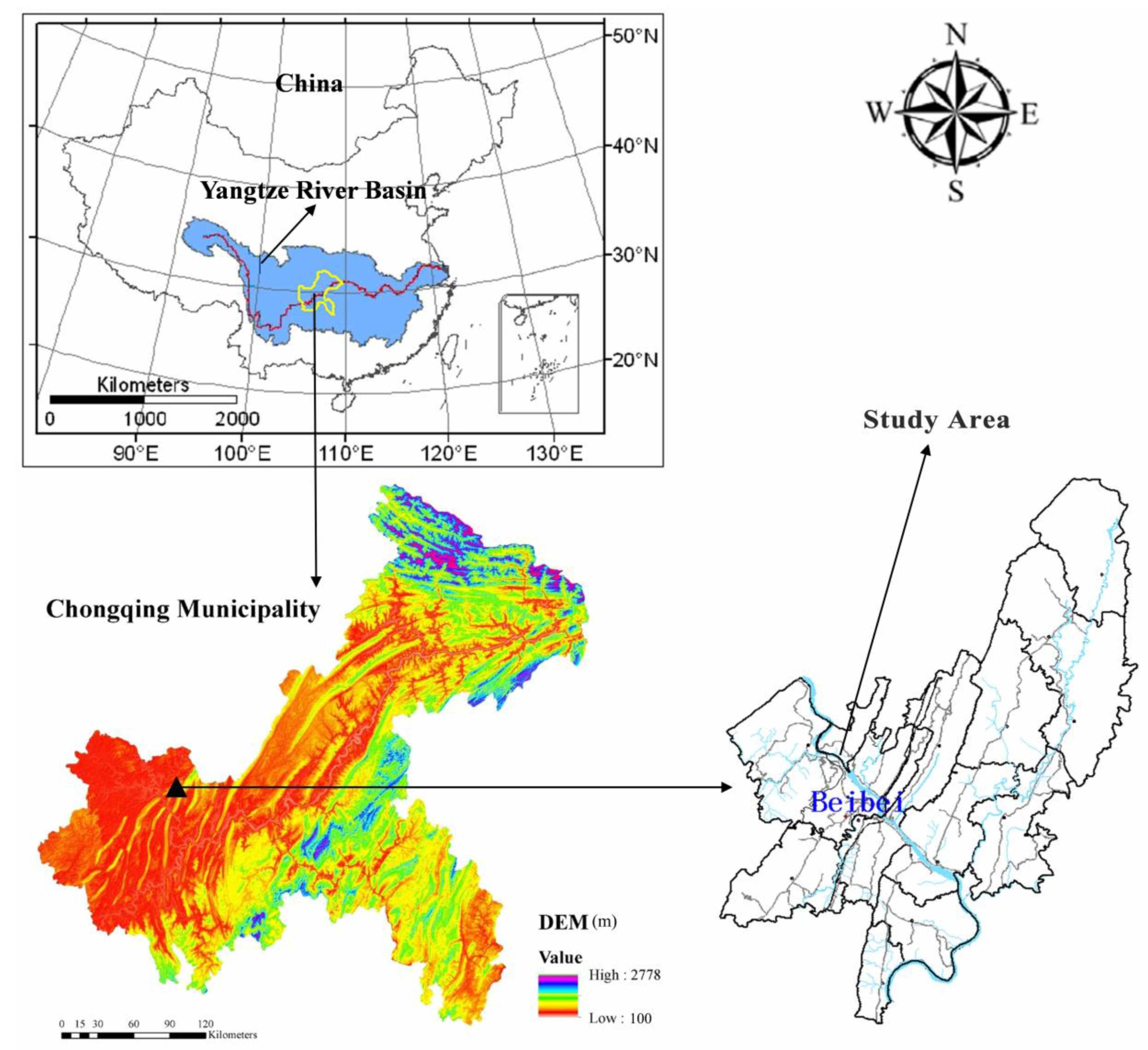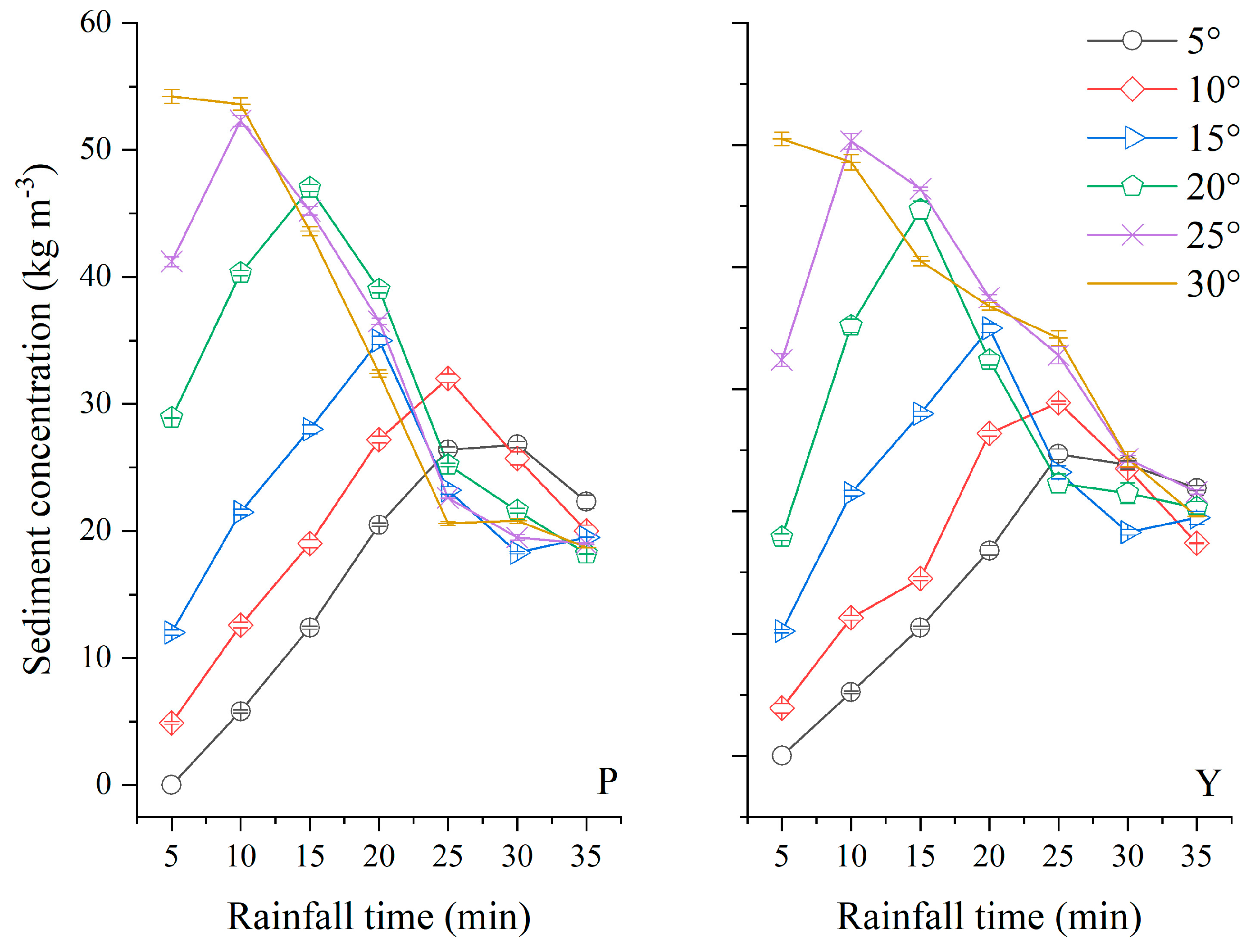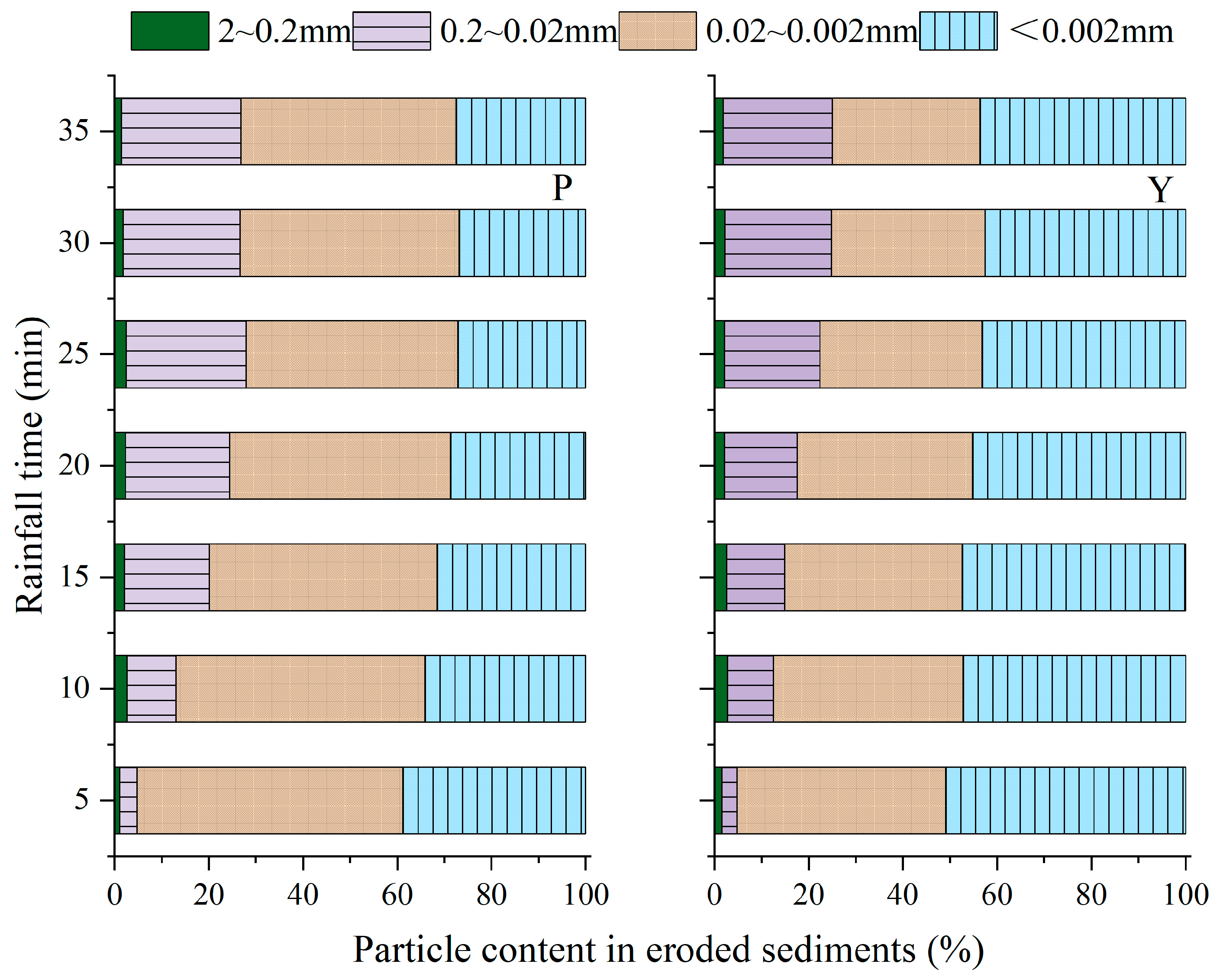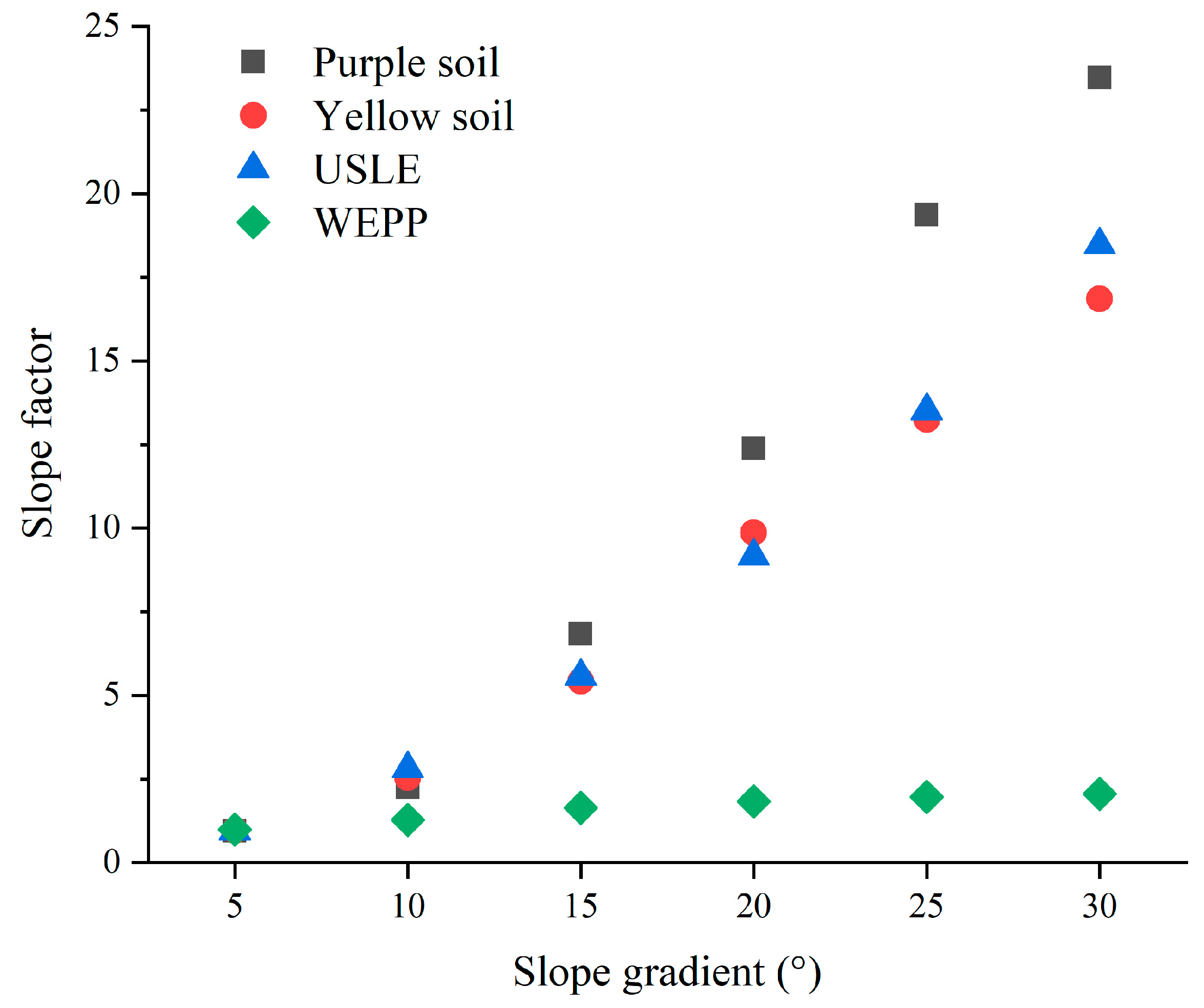Assessment of Erosion Characteristics in Purple and Yellow Soils Using Simulated Rainfall Experiments
Abstract
:1. Introduction
2. Materials and Methods
2.1. Study Area
2.2. Soil Testing and Analysis
2.3. Experimental Facilities and Rainfall Simulation
2.4. Index Determination
3. Results and Discussion
3.1. Soil Loss Response to the Rainfall Intensity and Slope Gradient
3.2. Particle Size Distribution in Surface Soils before and after Rainfall and in Eroded Sediments
3.3. Relationship between Erosion Rate and Slope Gradient
3.4. Slope Factor
4. Conclusions
Author Contributions
Funding
Institutional Review Board Statement
Informed Consent Statement
Data Availability Statement
Conflicts of Interest
References
- Montgomery, D.R. Soil erosion and agricultural sustainability. Proc. Natl. Acad. Sci. USA 2007, 104, 13268–13272. [Google Scholar] [CrossRef] [PubMed] [Green Version]
- Guo, Z.; Ma, M.; Cai, C.; Wu, Y. Combined effects of simulated rainfall and overland flow on sediment and solute transport in hillslope erosion. J. Soils Sediments 2017, 18, 1120–1132. [Google Scholar] [CrossRef]
- Drees, L.; Wilding, L.; Owens, P.; Wu, B.; Perotto, H.; Sierra, H. Steepland resources: Characteristics, stability and micromorphology. CATENA 2003, 54, 619–636. [Google Scholar] [CrossRef]
- Yang, Y.H.; Yan, B.X.; Zhu, H.; Wang, L.X. Effects of Water and Soil Conservation Practices on Reducing Pollution from Agricultural Nonpoint Source in Northeast China. Adv. Mater. Res. 2011, 356–360, 2473–2478. [Google Scholar] [CrossRef]
- Zhao, L.; Fang, Q.; Hou, R.; Wu, F. Effect of rainfall intensity and duration on soil erosion on slopes with different microrelief patterns. Geoderma 2021, 396, 115085. [Google Scholar] [CrossRef]
- Zhao, Q.; Li, D.; Zhuo, M.; Guo, T.; Liao, Y.; Xie, Z. Effects of rainfall intensity and slope gradient on erosion characteristics of the red soil slope. Stoch. Environ. Res. Risk Assess. 2014, 29, 609–621. [Google Scholar] [CrossRef]
- Liu, D.; She, D.; Yu, S.; Shao, G.; Chen, D. Rainfall intensity and slope gradient effects on sediment losses and splash from a saline–sodic soil under coastal reclamation. CATENA 2015, 128, 54–62. [Google Scholar] [CrossRef]
- Ziadat, F.M.; Taimeh, A.Y. Effect of rainfall intensity, slope, land use and antecedent soil moisture on soil erosion in an arid environment. Land Degrad. Dev. 2013, 24, 582–590. [Google Scholar] [CrossRef]
- Ebrahimi, M.; Nejadsoleymani, H.; Sadeghi, A.; Daneshvar, M.R.M. Assessment of the soil loss-prone zones using the USLE model in northeastern Iran. Paddy Water Environ. 2020, 19, 71–86. [Google Scholar] [CrossRef]
- Kinnell, P.; Wang, J.; Zheng, F. Comparison of the abilities of WEPP and the USLE-M to predict event soil loss on steep loessal slopes in China. CATENA 2018, 171, 99–106. [Google Scholar] [CrossRef]
- Miao, C.Y. Application of WEPP Model in Purple Soil Area and the Comparison of WEPP Model with USLE Model; Southwest University: Chongqing, China, 2005. (In Chinese) [Google Scholar]
- Han, Z.; Li, J.; Li, Y.; Gu, X.; Chen, X.; Wei, C. Assessment of the size selectivity of eroded sediment in a partially saturated sandy loam soil using scouring experiments. CATENA 2021, 201, 105234. [Google Scholar] [CrossRef]
- Sirjani, E.; Mahmoodabadi, M. Effects of sheet flow rate and slope gradient on sediment load. Arab. J. Geosci. 2012, 7, 203–210. [Google Scholar] [CrossRef]
- Shih, H.-M.; Yang, C.T. Estimating overland flow erosion capacity using unit stream power. Int. J. Sediment Res. 2009, 24, 46–62. [Google Scholar] [CrossRef]
- Miller, W.P.; Baharuddin, M.K. Particle Size of Interrill-eroded Sediments from Highly Weathered Soils. Soil Sci. Soc. Am. J. 1987, 51, 1610–1615. [Google Scholar] [CrossRef]
- Rienzi, E.; Fox, J.; Grove, J.; Matocha, C. Interrill erosion in soils with different land uses: The kinetic energy wetting effect on temporal particle size distribution. CATENA 2013, 107, 130–138. [Google Scholar] [CrossRef]
- Asadi, H.; Moussavi, A.; Ghadiri, H.; Rose, C. Flow-driven soil erosion processes and the size selectivity of sediment. J. Hydrol. 2011, 406, 73–81. [Google Scholar] [CrossRef] [Green Version]
- Warrington, D.N.; Mamedov, A.I.; Bhardwaj, A.K.; Levy, G.J. Primary particle size distribution of eroded material affected by degree of aggregate slaking and seal development. Eur. J. Soil Sci. 2008, 60, 84–93. [Google Scholar] [CrossRef]
- Shen, H.-O.; Feng, J.; Wang, D.-L.; Li, H.-L.; Wang, Y. Characteristics of soil erosion and sediment size distribution for different land uses in the Chinese Mollisol region. J. Mt. Sci. 2021, 18, 1295–1306. [Google Scholar] [CrossRef]
- Troy, T.J.; Forster, G.R.; Reina, K.G. Soil Erosion: Processes, Prediction, Measurement, and Control; John Wiley and Sons Ltd.: Hoboken, NJ, USA, 2002. [Google Scholar]
- Qian, F.; Cheng, D.; Ding, W.; Huang, J.; Liu, J. Hydraulic characteristics and sediment generation on slope erosion in the Three Gorges Reservoir Area, China. J. Hydrol. Hydromech. 2016, 64, 237–245. [Google Scholar] [CrossRef] [Green Version]
- Agrochemistry Committee of Soil Science Society of China. Conventional Methods of Soil and Plant Analysis; Science Press: Beijing, China, 1983. [Google Scholar]
- Acharya, B.S.; Blanco-Canqui, H.; Mitchell, R.B.; Cruse, R.; Laird, D. Dedicated Bioenergy Crops and Water Erosion. J. Environ. Qual. 2019, 48, 485–492. [Google Scholar] [CrossRef] [PubMed] [Green Version]
- Palis, R.; Okwach, G.; Rose, C.; Saffigna, P. Soil erosion processes and nutrient loss. 1. The interpretation of enrichment ratio and nitrogen loss in runoff sediment. Aust. J. Soil Res. 1990, 28, 623–639. [Google Scholar] [CrossRef]
- Martínez-Mena, M.; Castillo, V.M.; Albaladejo, J. Relations between interrill erosion processes and sediment particle size distribution in a semiarid Mediterranean area of SE of Spain. Geomorphology 2002, 45, 261–275. [Google Scholar] [CrossRef]
- Chaplot, V.A.M.; Le Bissonnais, Y. Runoff Features for Interrill Erosion at Different Rainfall Intensities, Slope Lengths, and Gradients in an Agricultural Loessial Hillslope. Soil Sci. Soc. Am. J. 2003, 67, 844–851. [Google Scholar] [CrossRef]
- Fox, D.M.; Bryan, R.B. The relationship of soil loss by interrill erosion to slope gradient. CATENA 2000, 38, 211–222. [Google Scholar] [CrossRef]






| Soil Type | pH | OM (g kg−1) | TN (g kg−1) | AN (mg kg−1) | TP (g kg−1) | AP (mg kg−1) | TK (g kg−1) | AK (mg kg−1) |
|---|---|---|---|---|---|---|---|---|
| P | 6.9 | 17 | 0.96 | 111 | 0.57 | 5.1 | 28.51 | 65.2 |
| Y | 7.5 | 24.9 | 1.5 | 123 | 0.76 | 7.5 | 19.14 | 87.1 |
| Soil Type | Items | >2 mm (%) | 0.2–2 mm (%) | 0.02–0.2 mm (%) | 0.002–0.02 mm (%) | <0.002 mm (%) |
|---|---|---|---|---|---|---|
| P | Before rainfall | 13.03 | 2.19 | 30.36 | 32.81 | 21.60 |
| After rainfall | 12.87 | 3.19 | 34.44 | 28.63 | 20.87 | |
| Eroded sediment | 1.95 | 18.56 | 48.82 | 30.67 | ||
| Y | Before rainfall | 4.32 | 8.75 | 27.41 | 27.04 | 32.48 |
| After rainfall | 5.85 | 9.66 | 29.35 | 24.87 | 30.28 | |
| Eroded sediment | 2.16 | 15.28 | 45.76 | 36.80 |
Publisher’s Note: MDPI stays neutral with regard to jurisdictional claims in published maps and institutional affiliations. |
© 2021 by the authors. Licensee MDPI, Basel, Switzerland. This article is an open access article distributed under the terms and conditions of the Creative Commons Attribution (CC BY) license (https://creativecommons.org/licenses/by/4.0/).
Share and Cite
Luo, B.; Han, Z.; Yang, J.; Wang, Q. Assessment of Erosion Characteristics in Purple and Yellow Soils Using Simulated Rainfall Experiments. Int. J. Environ. Res. Public Health 2022, 19, 357. https://doi.org/10.3390/ijerph19010357
Luo B, Han Z, Yang J, Wang Q. Assessment of Erosion Characteristics in Purple and Yellow Soils Using Simulated Rainfall Experiments. International Journal of Environmental Research and Public Health. 2022; 19(1):357. https://doi.org/10.3390/ijerph19010357
Chicago/Turabian StyleLuo, Banglin, Zhen Han, Jing Yang, and Qing Wang. 2022. "Assessment of Erosion Characteristics in Purple and Yellow Soils Using Simulated Rainfall Experiments" International Journal of Environmental Research and Public Health 19, no. 1: 357. https://doi.org/10.3390/ijerph19010357






